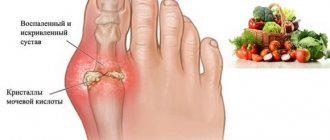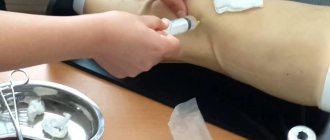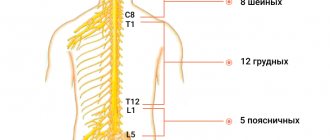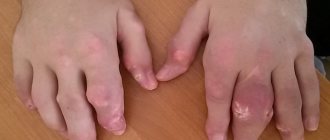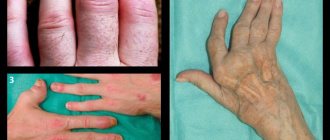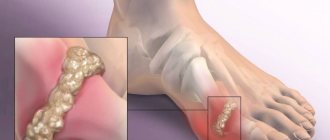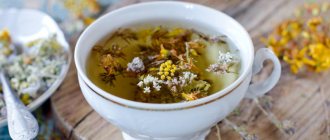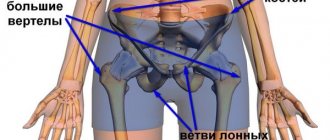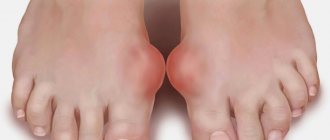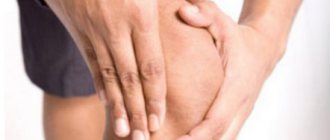Gout is an incurable disease that manifests itself as acute joint pain, stiffness of movement, formation of tophi, and impaired renal function.
Lack of medical supervision of the patient leads to such serious complications as secondary degenerative arthrosis, phlebitis, urolithiasis of the kidneys, gouty nephropathy. Pathology quite often becomes the cause of disability for the patient, and sometimes even ends in death.
Your doctor's recommendations will help you lead a healthy lifestyle if you have gout. A rheumatologist specializes in this disease.
Etiology of the disease
Gout is a chronic disease and it is not possible to cure it completely. Drug therapy and traditional methods, together with a proper diet and moderate physical activity, can prolong the remission process for several years. Symptoms of the disease may disappear completely, but after drinking alcohol they will reappear. See here what kind of alcohol you can use for gout.
Gout occurs primarily on the joints of the fingers, after which it spreads to the feet. Over time, its development leads to inflammation of other neighboring joints. The disease develops more often in older people, mainly men. In women it begins after 55 years, during menopause, due to a sharp decrease in estrogen production. Gout does not occur in children and young and middle-aged people. Although there are extremely rare exceptions related to heredity. The disease is always accompanied by metabolic disorders.
How does a rheumatologist consult for gout?
At the initial stage of admission, the doctor asks the patient about the characteristic manifestations of the disease and finds out the reasons that provoked its development (poor diet, exposure to bad habits, previous surgical operations, kidney problems, long-term course of steroids or antibiotics).
After collecting anamnesis, the doctor conducts an external examination to assess the clinical picture of the disease. Before making a final diagnosis, the rheumatologist refers the patient for additional examinations:
- general clinical and biochemical blood test;
- synovial fluid analysis;
- analysis of tophi contents;
- Ultrasound, x-ray, affected joints;
- scintigraphy (with the introduction of technetium pyrophosphate).
Causes
The main cause of joint dysfunction is excessive accumulation of uric acid in the body and its penetration into joint tissues through the bloodstream. The main element of uric acid is sodium urate, which turns into crystals and accumulates on the joints, causing their gradual complete destruction. The reason for the accumulation of uric acid is an incorrect diet, which contains large quantities of foods high in purine - fatty meats and fish, and alcohol abuse. An increase in the concentration of uric acid is associated with dysfunction of the kidneys, which do not remove its excess from the body.
Other possible factors for the development of gout:
- Hypertension.
- Excess body weight.
- Kidney failure.
- Diabetes.
- Diseases of the gastrointestinal tract.
- Poor diet – fatty meat and fish, frequent consumption of mushrooms and legumes.
- Lack of physical activity.
- Excessive consumption of alcoholic beverages, in particular beer.
- Heredity.
Without timely diagnosis and treatment, gout develops and affects all joints, starting from the fingers. In most cases, the disease becomes chronic.
Localization area
Urate deposits are most often observed in areas with a poorly developed vascular network. The temperature in these areas is lower compared to other parts of the body.
In most patients, tophi are localized in the following areas:
- fingers and toes;
- ears;
- feet;
- knees;
- elbow joint area.
In particularly serious cases, when the level of uric acid in the body exceeds all permissible norms, urates begin to accumulate in the internal organs. We are talking about kidneys and bone tissue.
Clinical picture
Gout has 4 stages of development:
- The first stage – there are no symptoms.
- The second stage is the development of acute gouty arthritis.
- The third stage is a period of calm between critical states.
- The fourth stage is gout of the chronic stage.
Stages of development of gout
Symptoms of the disease appear at the acute stage, which is observed after drinking alcoholic beverages or after eating too fatty foods:
- Acute pain in the joints. Present in the morning and evening hours.
- Attenuation of pain syndrome during the daytime.
- Inflammation of joint tissue. As a rule, the inflammation affects the big toe.
- Joint swelling.
- Increased body temperature.
- Redness of the skin that surrounds the inflamed joint.
- Feeling nauseous.
- Heartburn.
- Increased blood pressure.
- Lack of appetite.
The chronic stage of gout begins to develop after 2-3 years if it is not treated during the exacerbation period. The disease causes the development of pathologies of internal organs, in particular, it leads to disruption of the kidneys, provokes the development of urolithiasis, and gouty type nephritis.
One of the complications that joint disease leads to is the formation of tophi. Tophi are nodes formed from uric acid crystals. They are yellowish in color and are located on the elbow joints, fingers of the upper and lower extremities, on the feet, or on the ears. Uric acid crystals can burst over time, causing severe pain in a person. Tophi are a foreign element for the human body. When they form, the immune system begins to actively fight tumors, which leads to an increase in the level of leukocytes in the circulatory system. An inflammatory process is formed. In most cases, the disease is accompanied by the development of diabetes and rapid weight gain.
Gout is an extremely dangerous disease. Its treatment must be timely and correct, otherwise the formation of kidney stones is possible, which, causing urolithiasis, can cause death.
What happens to joints with gouty arthritis?
Being a metabolic disorder, gout is associated with insufficient excretion of uric acid by the kidneys. Because of this, breakdown products begin to accumulate in the blood (in particular, in plasma), causing hyperuricemia. Hyperuricemia itself does not mean the onset of gout - it can occur as a result of excessive fatty foods or physical overload. However, this pathology causes damage to the renal glomeruli and gradually leads to kidney damage and, as a consequence, gouty arthritis. The symptoms of gouty arthritis cannot be ignored - they seem to warn the patient of even more serious complications. Thus, excess uric acid in the blood negatively affects the cardiovascular system, increasing the risk of heart attack and stroke.
Over time, monosubstituted sodium urate crystallizes in the joints, kidneys, forehead, earlobes and other tissues 5-6 years after the onset of the disease, causing thickening of the connective tissue (tophi). Over time, tophi can grow in clusters on the affected areas, reducing the quality of life of patients and requiring treatment of gouty arthritis with drugs.
Often the consequence of gouty nodes is inflammation of the periarticular bursae and tendons. It not only causes pain in the joint, but also gradually leads to a limitation of its mobility. Gout is accompanied by extensive erosion of the articular surfaces caused by calcium deposits in adjacent tissues, as well as impaired formation and destruction of bone tissue.
The disease also leads to the formation of kidney stones (uric acid stones), a chronic inflammatory process and renal colic.
Diagnosis and treatment methods
Before treating gout, it is necessary to ensure that the diagnosis is correct, which is made in the presence of a certain clinical picture and the results of medical tests. The patient must undergo an ultrasound examination of damaged joints, an electrocardiogram and donate blood for a general analysis. A urine test is performed to study kidney function. In some cases, magnetic resonance imaging may be necessary to confirm the initial analysis.
Treating gout means completely reconsidering your lifestyle, giving up many habits and changing your diet. The main method of therapy is taking medications prescribed by the attending physician for each individual case, depending on the patient’s age, the severity of the symptomatic picture and the presence of possible complications.
Drug therapy is aimed at controlling the level of uric acid in the human body and removing its excess.
First of all, the patient is prescribed non-steroidal drugs that are intended to treat inflammatory processes in the joints - diclofenac, naproxen, methindol. The course of their administration is from one to two weeks. To normalize the concentration of uric acid in the body as soon as possible, milurite, orotic acid, and hepatocatazal are prescribed. Taking colchicine helps treat the acute stage of the disease, relieving painful symptoms.
Before treating gout, it is necessary to undergo a full medical examination to identify the causes of its occurrence. Excessive consumption of fatty foods leads to the accumulation of fat in the body, which delays the process of excretion of uric acid by the kidneys and the accumulation of protein. If you are overweight, the joints of the human body experience greater stress. This condition aggravates the inflammatory process in the joint tissue. To date, scientists have thoroughly studied the connection between insufficient calcium levels and the development of gout. The concentration of calcium in the human body decreases due to age-related changes and due to poor diet. To prevent calcium leaching, people over 40 need to take vitamin courses.
A new drug that will help effectively treat gout is Benzobromarone, but it is currently undergoing clinical trials.
The main drugs for the treatment of gout:
- Allopurinol.
- Uloric (Febukostal).
- Pegloticase.
- Probenecid.
- Colchicine.
- Cortisone.
- Prednisolone.
- Aspirin.
- Diclofenac.
- Ibuprofen.
How to prepare for the initial examination by a doctor?
Typically, the rheumatologist refers the patient to undergo laboratory tests, so 2 days before his visit it is necessary to give up alcohol and smoking. You must come to your appointment on an empty stomach, and you are also prohibited from drinking tea, coffee, or sweet drinks.
A consultation with a specialist will be much more productive if the patient makes a list of questions that interest him in advance (about treatment options, side effects of prescribed medications, the need for lifestyle changes, etc.).
The doctor should be shown a list of medications you are taking (including over-the-counter medications, vitamins, and herbal supplements).
For the examination, it is recommended to choose comfortable clothing that is easy to remove. Don't forget about personal hygiene: take a shower in the morning and put on clean underwear.
What to do during an exacerbation of gout
Gout is a disease that must be treated as soon as the first symptoms appear. The exacerbation of the disease is extremely severe, preventing the patient from leading a normal life. To relieve painful symptoms and remove such an unpleasant phenomenon, you must do the following:
- Immobilize the inflamed joint by fixing it in an elevated state using an elastic bandage or a special bandage.
- Frequent use of aspirin is prohibited, as it causes an abrupt change in the amount of uric acid.
- Patients with gout who experience an increase in its symptoms need to constantly measure the concentration of uric acid. At the slightest deviation from the norm, you must immediately start taking medications.
- Exercising should become a daily habit. The most acceptable types of physical exercise are running, swimming, cycling, dancing.
- Drinking the daily norm of plain water, which activates the work of the kidneys to eliminate waste by-products. Its required amount is at least two liters per day.
- Taking vitamin complexes. To determine which vitamins are missing in the body, the patient needs to do a detailed blood and urine test.
- Patients with gout are strictly prohibited from drinking carbonated and alcoholic drinks. The ban applies to the consumption of powdered juices.
- Changing the diet, which should include vegetables and fruits, cereals. Store-bought sausages and food products with a high content of animal proteins should be consumed rarely, in small quantities.
Physiotherapy and massage
As is the case with other disorders of the musculoskeletal system, the fight against gouty tophi is not complete without physiotherapy. It helps normalize blood circulation in the affected area and relaxes muscle muscles. The use of specific procedures depends on the stage of the pathology:
- in the acute phase, pulse points and treatment with UV rays are used;
- At the stage of remission, it is advisable to use ultraphoresis and mud therapy.
If there is no pain at home, you can perform self-massage sessions. It is recommended to begin the procedures with stroking the periphery of the joint and light rubbing, gradually moving to adjacent tissues. This approach promotes overall muscle relaxation. For gout, massage should begin from distant areas, sequentially approaching the source of pain. The duration of one procedure should not exceed 15 minutes.
Consider the example of gouty tophi on the toe. In this case, the massage should begin from the lower leg, gradually approaching the epicenter of the pain. A gentle effect on the affected joint stimulates blood circulation, which helps remove sodium urates into the blood. Intensive movements are strictly prohibited. Also, you should not conduct sessions during the period of exacerbation of the pathology.
Symptoms of gout in women
Signs of gout in women are completely absent for a long time, although there will already be deviations in the biochemical blood test. Even if there are no signs of gout in women, it may be necessary to prescribe treatment. Therefore, if there are any deviations during a preventive examination, it is better to consult a specialist.
The first signs of gout in women that are visible clinically are pain, swelling, hyperemia and hyperthermia of the joints. Most often, gout manifests itself in the joint of the big toe. The joints of the thumb, ankle, knee and elbow are somewhat less commonly affected. Symptoms of gout in women are characterized by severe pain, severe limitation of mobility, swelling and redness of the joints. The pain is intense, constant, the maximum peak is in the first day. After two or three days, as a rule, in the case of the first attack, the pain goes away on its own.
After a sufficiently long period of “calm”, against the background of full health, a second attack occurs. Over time, the attacks will last longer and longer, and the periods of remission will become shorter. The progression of gout leads to the disappearance of the period between attacks and the disease leads to chronic gouty arthritis.
At the stage of chronicity of the process, the clinical picture already shows specific signs of gout in women: gouty nodules - tophi. Their favorite localization is the ears, fingers, toes, etc. Symptoms of involvement of the urinary system are also added. Nephrolithiasis, pyelonephritis, cystitis, etc. are typical.
With the right treatment, it is possible to achieve long-term remissions, reduce the number of attacks, and make them less intense. Quality treatment can prevent the kidney symptoms of gout in women. The choice of treatment method in the future depends on the presence of signs of gout in women.
YOU can call us: 8 (8452) 98-84-68 and +7-967-500-8468 or
Gout
Gout is a systemic tophi disease characterized by the deposition of monosodium urate crystals in various tissues and the resulting inflammation in individuals with hyperuricemia (increased levels of uric acid) caused by environmental and/or genetic factors.
Gout is a disease that, except in rare cases and unlike other chronic arthritis, is highly treatable. In the absence of advanced and irreversible cases of renal failure, with proper management of the patient and its adequacy, almost complete reverse development of the disease process is possible. If this does not happen, then there is reason to doubt the reliability of the diagnosis of gout. Therapy includes: treatment of arthritis (acute or chronic), therapy aimed at reducing uric acid levels, diet, lifestyle changes. What do doctors usually do to make a diagnosis? Typically, an X-ray of the inflamed joint and a serum uric acid (UA) level are performed. If a fracture is suspected or there is a history of trauma, an x-ray examination may be useful, but it will not be possible to diagnose early gout with its help, since its typical signs appear later and are x-ray-negative tophi, which are called the “piercer symptom.” Intraosseous tophi appear on average at the 7th–8th year of the disease, when their diagnostic value is lost due to the presence of tophi in visible localizations. Moreover, the percentage of discrepancies in the assessment of radiographs - whether they are tophi or pseudocysts in osteoarthritis - is high even at a late stage of the disease.
Determining the level of UA also does not help determine the diagnosis: hyperuricemia is a common symptom of other arthritis, the onset of which may be similar to the onset of gout (pyrophosphate arthropathy, osteoarthritis, psoriatic arthritis). It is also difficult to use these data for further selection of antihyperuricemic therapy, since urinary levels decrease during an attack of arthritis and it will be difficult to assess the effectiveness of allopurinol in the future. In this regard, the main task during this period is to quickly and safely relieve arthritis.
Arthritis treatment
Important! 1. Avoid alcohol during an attack (it helps to increase the duration of the attack, there is an undesirable interaction with medications). 2. Drink plenty of liquid: green tea, mineral water, unsweetened berry fruit drinks. 3. Home regimen (due to severe pain, blood pressure may rise, there is a risk of developing cardiovascular accidents). 4. Follow a strict diet. 5. Do not wait for the attack to resolve itself, start effective therapy. One of the drugs that has a rapid onset of anti-inflammatory effect is nimesulide. Drugs such as artrosilene and arcoxia have proven themselves well in the treatment of gouty arthritis. The use of glucocorticoids (GC) in acute gouty arthritis
Intra-articular administration of GC for gouty arthritis on an outpatient basis is a well-known approach recommended by the European League of Rheumatology. Colchicine Colchicine is prescribed mainly when there are contraindications to taking NSAIDs or when they are ineffective. High doses of colchicine lead to the development of side effects, while low doses (0.5 mg 1–3 times/day) are safe and can be prescribed to a number of patients with acute gouty arthritis. Unfortunately, colchicine is currently not available in the Russian Federation. However, patients can bring it from other countries.
Allopurinol
Allopurinol (Milurit) does not have a direct analgesic effect, so during an exacerbation of gout it is useless for pain relief. BUT: regular use of this drug helps eliminate pain in the future
Allopurinol tablets are taken orally after meals. The daily dose of the medicine is calculated by the doctor, taking into account the severity of the disease and the concentration of uric acid in the blood.
Treatment is usually started with minimal doses, gradually increasing them to the required level under the control of a blood test.
If you take Allopurinol, strictly following the doctor’s recommendations, then after six months or a year you can notice significant progress: the intensity and frequency of attacks of gouty arthritis becomes less and less frequent, tophi begin to resolve and soften (nodules limited by connective tissue - deposits of uric acid salts).
Treatment with Allopurinol is a long-term and continuous process. It is possible, although not advisable, to take a break for 2-3 weeks, but subject to normal blood and urine counts and only with the permission of a doctor.
It is not recommended to interrupt the medication on your own, since when Allopurinol is discontinued, the level of uric acid begins to increase already on the 3-4th day.
You cannot start treatment with these drugs during an acute attack; treatment is carried out only in the interictal period!!!
Treatment of associated conditions For patients with gout and arterial hypertension It is important to know: 1. All diuretics increase the level of sUA. 2. Diuretics prescribed for health reasons (heart failure) to patients with gout must be compensated by taking allopurinol, which requires observation by a rheumatologist in order to titrate the dose. 3. If the patient has uncomplicated hypertension, it is advisable to discontinue diuretics. The tactics of patient management should be almost the same when prescribing anticoagulants, which also help increase the level of sUA. The prescription of drugs “friendly” to MK - losartan, metformin, fenofibrate, vitamin C - is carried out in accordance with the indications for the use of these drugs.
Purina Diet Patients should avoid eating foods high in purines, which include seafood and offal (offal). Meat has a relatively high purine content, but this depends on how it is prepared. Thus, patients with gout are not recommended to consume rich soups, as well as jelly, jellied meat, sausages, etc., but they can eat meat boiled in several waters. Mushrooms and plant foods such as asparagus, cauliflower, spinach, lentils and soy are also rich in purines, but recent studies have shown that consuming plant purines does not increase blood levels of uric acid and does not lead to the development of gout. The production of endogenous purines increases with the consumption of large amounts of protein, so the diet of a patient with gout should limit proteins of animal origin. On the other hand, the amount of protein should be at least 1.5 g per 1 kg of weight to prevent and reduce the effects of fatty liver disease. Recent large studies have shown that consuming low-fat dairy products leads to lower UA levels and a reduced incidence of gout. This is due to the fact that the proteins casein and lactalbumin contained in dairy products increase the excretion of sUA in the urine. Alcohol. One of the main risk factors for developing gout is alcohol. It is necessary to exclude the consumption of beer, port wine, strong alcoholic drinks (whisky, cognac, etc.). As the results of recent studies have shown, drinking a glass (250 ml) of wine per day did not lead to an increase in the level of sUA in the blood. However, the grapes from which dry wine is produced contain a lot of fructose, which contributes to hyperuricemia, so drinking more wine per day is fraught with an increase in uric acid levels and an exacerbation of the disease. At least three days a week should be alcohol-free. Alcohol may increase sUA levels by not only increasing urate production but also decreasing renal clearance. In particular, acute alcoholic excess causes a decrease in urate excretion. Chronic alcohol consumption stimulates the production of purines. The nature of the alcohol also matters. Thus, the purine components of beer cause hyperproduction of urates. The components of whiskey, port wine and other strong alcoholic drinks include lead, which reduces the excretion of sUA. Alcohol can affect the metabolism of drugs. Alcohol consumption reduces the effect of allopurinol due to suppression of the formation of its active metabolite, oxypurinol, which is associated with the low effect of allopurinol in patients with gout who continue to drink alcohol. To prevent stone formation, patients with gout should receive enough fluid to produce at least 2 liters of urine per day. It is allowed to drink water, including mineral water, skim milk, citrus juices and berry fruit drinks, tea and coffee. Green tea has a powerful uricosuric effect. Drinking 5 or more cups of coffee per day has also been shown to have a moderate but significant uricosuric effect. Long-term coffee consumption is associated with a reduced risk of developing gout. Carbohydrates. Currently, the negative effects of fructose contained in drinks and foods are known, which, unlike other sugars, increases sUA levels. Thus, it was shown that in people who ate 5 apples at the same time, the level of UA increased by 35% (due to fructose). Recent studies have demonstrated a direct link between fructose intake and the development of gout in men. On the contrary, taking vitamin C leads to a decrease in the level of sUA in the blood due to increased excretion of sUA in the urine. In general, studies have shown that weight loss caused by reducing carbohydrate intake and increasing the amount of protein and unsaturated fats leads to a decrease in sUA levels and the incidence of gout attacks.
What it is
The appearance of nodular growths signals an advanced form of gout. Tophi appear due to the accumulation of small compounds of sodium salts formed by excess urates in the blood. The more of these compounds in the body, the faster the tophi grows, affecting the soft tissue surrounding the joint. The accumulation of urate deposits is associated with impaired blood flow in joints in people over 45 years of age.
Surgical intervention
When conservative treatment is ineffective, surgical removal of the formation is recommended. In addition, surgery is used in the following cases:
- urate deposits have reached excessive levels;
- there is severe deformation of the articular structure;
- the nodules have grown into nearby tissues.
The operation itself for gouty tophi consists of several stages. First, local anesthesia is administered. A small incision is then made on the affected area. Through it, the bag with pathological tissues is excised. This area is washed with antiseptic solutions and cosmetic stitches are applied.
The patient remains in the hospital under observation for the next 7-10 days. He gets bandages every day. After 10 days, the sutures are removed and the operated area is examined by a doctor. If the result is positive and there are no complications, the patient is sent home.
Help from traditional medicine
How to remove gouty tophi on the fingers and toes using unconventional means? Recipes from traditional healers are usually aimed at improving metabolic processes in the body. It is unlikely that it will be possible to completely get rid of the nodules, but it is possible to stop the signs of tissue inflammation. Below are the most effective methods of influencing the problem.
- A decoction based on stinging nettle leaves, flaxseeds and lingonberries. To prepare it, you will need to mix all the ingredients in equal proportions and pour boiling water over it and leave for 2 hours. It is recommended to take half a glass of the decoction before meals.
- Baths with Siberian larch branches. Oat straw can be used as an auxiliary ingredient. The procedure should be repeated 2-3 times a week, and the duration of one session should not exceed 20 minutes.
Large tophi can be reduced by using potato pulp or cabbage leaves as compresses. The iodine network has an excellent therapeutic effect. It is recommended to apply it directly to the formation itself.
What parts of the body are affected?
The formations usually considered under the dermis occur in the following areas:
- ears;
- elbow joints;
- forehead;
- shins;
- hips;
- feet.
When tophi is localized inside the periarticular tissues, the patient begins to experience intense pain due to inflammation of the ligaments and cartilage.
Gout nodes are localized in the following tissues:
- muscles;
- subcutaneous fat layer;
- Bone marrow;
- joints;
- heels;
- ligamentous apparatus.
When tophi are localized inside adipose tissue, bones, muscles, the patient does not experience pain. If the nodes are located in the joints or ligaments, pain of varying intensity may appear. This is explained by the strong innervation of these anatomical structures.
During remission, tophi are characterized by a static position, no increase in size, and a tendency to recur. When the disease progresses and gout is not adequately treated, gout nodes grow. At the same time, the surrounding tissues are compressed, the inflammatory process begins, and the pain syndrome intensifies (for any localization of pathological formations).
Over many years of practice, specialists have discovered the favorite localization of tophi, which is represented by small joints of the hands, feet, auricular cartilage, and elbow joints. This greatly facilitates the differential diagnosis of the pathology in question with rheumatic nodes and nodes of other etiologies.
Quite rarely, tophi occur in the following areas:
- cornea of the eye;
- shin;
- penis;
- hips;
- forearm;
- scrotum.
What it looks like and why it appears
Most often, gouty tophi is localized in the subcutaneous layer of tissue around the diseased joint. In rare cases, it can be found intraosseously, on internal organs. This is a dense round growth up to 8 mm in diameter, having a yellowish color. The skin near the growth is dry and rough to the touch.
Nodules localized on muscle, bone tissue or in the fat layer do not cause discomfort. This is more of a cosmetic defect. If tophi in gout are located on a joint or ligament, pain of varying intensity occurs. This is explained by the large number of nerve endings at their localization sites.
While the disease is in remission, the nodules do not grow. A sharp increase in size occurs with exacerbation or non-compliance with treatment recommendations. As a result, adjacent soft tissues are compressed, blood circulation is disrupted, and the node becomes inflamed and painful.
Tophi with gout affect certain areas of the body:
- small joints of the limbs;
- ear cartilage;
- elbow joint;
- bends of the forearm, thigh or lower leg;
- internal organs.
With active gout, the nodule may open. At the site of the tophi, a fistula forms, from which white crumbs or yellow liquid are released. The process is accompanied by fever and severe pain.
